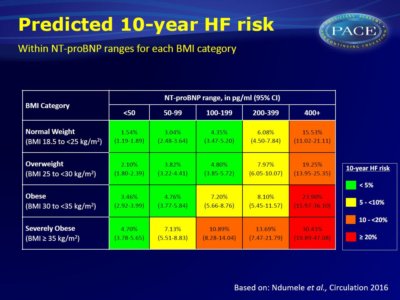Slight elevations in NT-proBNP may flag an increased absolute HF risk in obese subjects
In a large community-based cohort, NT-proBNP provided significant prognostic information regarding the risk of developing HF even among individuals with obesity.
The Atherosclerosis Risk in Communities (ARIC) StudyLiterature - Ndumele CE, et al. Circulation. 2016
N-Terminal Pro-Brain Natriuretic Peptide and Heart Failure Risk Among Individuals With and Without Obesity
Ndumele CE, Matsushita K, Sang Y, et al.
Circulation. 2016;133:631-638
Background
The addition of NT-proBNP, the N-terminal fragment of the prohormone for BNP, to traditional risk factors significantly improves the risk prediction of HF [10], since it is:- a diagnostic marker for HF severity [1]
- associated with subclinical LV dysfunction in asymptomatic subjects [2]
- independently associated to incident HF in the general population [3]
- proBNP is inversely associated with BMI, e.g. lower among obese individuals irrespective of the existence or absence of HF [4], although obesity is associated with HF [5]
- there is a poor correlation between natriuretic peptide levels and LV filling pressures among obese subjects compared with those who are not obese [6]
- obese patients undergoing cardiac catheterization have lower NT-proBNP levels, despite higher average LV end-diastolic pressures [7]
This study assessed the utility of NT-proBNP for HF risk prediction across different BMI categories in the Atherosclerosis Risk in Communities (ARIC) Study, a community-based cohort of 15.792 middle-aged individuals, who had no history of HF at baseline, and were followed-up for a median of 20.6 years. 12.230 ARIC participants free of prior HF at baseline and with BMI ≥ 18.5 kg/m2 were followed up.
Main results
• NT-proBNP was inversely correlated with BMI: Pearson correlation coefficient: −0.10; P<0.001• Higher BMI category at baseline was associated with higher rates of HF, with incidence rates per
1000 person-years:
- normal weight: 5.6
- overweight: 7.5
- obesity: 11.6
- severe obesity: 16.8
- normal-weight: <5%
- severe obesity: >10%
- severe obesity: 11.0
- normal weight: 5.1
• Assessment of the NT-proBNP levels leading to pre-specified 10-year HF risk of 10% in each BMI category at mean levels of all covariates:
- severe obesity: median NT-proBNP levels of 119 pg/mL (95% CI: 83–177 pg/mL)
- obesity: median NT-proBNP levels of 289 pg/mL (95% CI: 195–500 pg/mL)
- overweight: median NT-proBNP levels of 473 pg/mL (95% CI: 318–778 pg/mL)
- normal-weight: median NT-proBNP levels of 489 pg/mL (95% CI: 367–703 pg/mL)

Conclusion
In a large community-based cohort with a long follow-up, NT-proBNP provided significant prognostic information regarding the risk of developing HF even among individuals with obesity, despite its inverse relationship with BMI. Due to the higher baseline HF risk among obese individuals, slight elevations in NT-proBNP may flag an increased absolute HF risk.Find this article online
References
1. Bettencourt P, Azevedo A, Pimenta J, et al. N-terminal-pro-brain natriuretic peptide predicts outcome after hospital discharge in heart failure patients. Circulation. 2004;110:2168–2174
2. Luers C, Wachter R, Kleta S, et al. Natriuretic peptides in the detection of preclinical diastolic or systolic dysfunction. Clin Res Cardiol. 2010;99:217–226
3. Wang TJ, Larson MG, Levy D, et al. Plasma natriuretic peptide levels and the risk of cardiovascular events and death. N Engl J Med. 2004;350:655–663
4. Krauser DG, Lloyd-Jones DM, Chae CU, et al. Effect of body mass index on natriuretic peptide levels in patients with acute congestive heart failure: a ProBNP Investigation of Dyspnea in the Emergency Department (PRIDE) substudy. Am Heart J. 2005;149:744–750
5. Kenchaiah S, Evans JC, Levy D, et al. Obesity and the risk of heart failure. N Engl J Med 2002; 347:305 –313
6. Dokainish H, Gonzalez R, Hartley WB, et al. Usefulness of B-type natriuretic peptide levels to predict left ventricular filling pressures in patients with body mass index >35, 31 to 35, and < or =30 kg/m2. Am J Cardiol. 2007;100:1166–1171
7. Taylor JA, Christenson RH, Rao K, et al. B-type natriuretic peptide and N-terminal pro B-type natriuretic peptide are depressed in obesity despite higher left ventricular end diastolic pressures. Am Heart J. 2006;152:1071–1076
8. Madamanchi C, Alhosaini H, Sumida A, et al. Obesity and natriuretic peptides, BNP and NT-proBNP: mechanisms and diagnostic implications for heart failure. Int J Cardiol. 2014;176:611–617.
